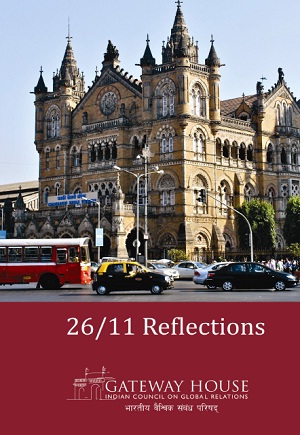In the aftermath of the Mumbai terrorist attack on 26 November 2008, several questions arose on what entity should be held legally responsible and the applicability of international instruments in prosecuting both state and non-state perpetrators. What were the options available to India? What instruments, under international law, could be applied by India? What was the precedent set by the U.S. intervention in Iraq and Afghanistan after 9/11?
For the 6th anniversary of 26/11, Gateway House reached out to law students to engage them in conversation on the legal rights and responsibilities of India and Pakistan on the international stage in the aftermath of the attack. The conversation highlights are given below.

Q. What entity did India hold legally responsible for the 26/11 attack on Mumbai? What aspect of international law is applicable in this situation?
Anushka Shah, 2nd year student, Government Law College, Mumbai
The terrorist attack in Mumbai on 26 November 2008 (26/11) was carried out by Lashkar-e-Tayyiba (LeT), a group based in Pakistan. India had evidence that the terrorists received military training in Pakistan, which was denied by the Pakistani government. Following the incident, the Pakistani government has not taken any substantial action. The conclusions of the 17th SAARC summit in the Maldives highlighted the lack of progress in Pakistan’s promise to persecute the individuals responsible for the Mumbai attacks.
Pakistan is in clear violation of UN Security Council Resolution (UNSCR) 1456 of 20 January 2003 which notes that “States must bring to justice those who finance, plan, support or commit terrorist acts, or provide safe havens, in accordance with International law, in particular on the basis of the principle to extradite or prosecute.”
This brings us to the question of State Responsibility – can Pakistan be held legally responsible for the acts of LeT and other jihad-based terror groups? The perpetrator who was caught by the Mumbai police, Ajmal Kasab, stated that the attacks were carried out with the support of Pakistan’s intelligence agency, ISI. If that is true, the question of imputability to Pakistan is answered. If we are to hold that Kasab’s charge may not be true until it is proven, then Pakistan’s responsibility may need more justification under International Law, based on the principle of State Responsibility for Private Actors. This principle covers ‘General Standards’ of State Responsibility along with ‘Special Standards’ in order to cover any internationally abusive act which may be left out of the jurisdiction of the General Standards. Standards of attribution in cases of non-state acts of terrorism are not entirely settled. However, it is agreed that providing safe harbor to terrorists and comparable support by States constitutes a threat, and therefore may be attributed to the State. Although a practical reference to this may only be found in a UNSC resolution 1373/2001 concerning the Al-Qaeda acting from Afghanistan against the U.S., it represents the commitment of the international community towards attributing the use of force on foreign territories by private actors to States. In addition, a State may be responsible for acts or omissions of organs that are linked to the private act in question. This applies in cases of a lack of due diligence. Pakistan’s reluctance in accepting responsibility and in turn providing a safe haven to terrorists furthers its lack of due diligence.
Q. What were India’s legal options? What legal instruments did India use, and were they effective?
Harshit Jaiswal, 2nd year student, Government Law College
The legitimate options to combat terrorism by states can be interpreted through state practice and international legal instruments sanctioned by the UN. India’s legal options to persecute the perpetrators of the 26/11 attack were ambiguous and indefinite, complicated by the gravity of the terrorist act, the non-state organisation involved and India’s relations with Pakistan.
One of the options available was Legitimate Self Defence. Article 51 of the UN Charter provides for individual and collective right of self-defence to a state until necessary measures are taken by the Security Council to maintain peace and security. The precondition for the use of this right lies in establishing that the victim state has been subject to an ‘armed attack’, where the armed attack can be ‘attributed’ to another state. The use of force must be necessary and proportionate. While the gravity of the attack determines its armed nature, tendering any level of support or willingly hosting, tolerating or harbouring terrorists, will make the non-state actor attributable to the state offering such support. This right was exercised by the U.S. for intervention in Afghanistan post 9/11.
Lawful Intervention, based on humanitarian grounds, was another option. The intervening state can articulate a justification stressing the gravity of the terrorist act and the unacceptable and compelling character of the situation in order to vindicate their own breach of international law, along with the inability of the host state to combat terrorism.
Counter-measures as well are accepted in principle, subject to the requirements of necessity and proportionality, and to be distinguished from self-defence by its character as an enforcement measure aimed at inducing compliance with international law. Counter-measures are essentially reprisals which do not involve the use of force.
Recourse to International Penal Jurisdiction was a fourth option. This involves the creation of an international penal jurisdiction, competent to hear and decide cases of terrorism. However, legal and practical difficulties may come to be associated with the functioning of an international tribunal to judge these crimes.
India adopted passive legal measures within the limits of its internal and external policy on counter-terrorism such as diplomatic pressure on Pakistan for the arrest and trial of LeT’s top leadership, Coastal Security Schemes, Amendment of Unlawful Activities (Prevention) Act, etc. The diplomatic pressure imposed by India and the international community resulted in Pakistan raiding LeT’s headquarters, indictment of seven perpetrators in connection with the attack, and freezing of the Jamat-ud-Dawa bank accounts.
The trial of the perpetrators has not proved to be conclusive – a Pakistani judicial commission arrived in India to carry out the investigation and cross examine the witnesses, but its report had been rejected by an anti-terrorism court in Pakistan due to lack of evidence.
Q. What are the challenges in combating terrorism under international law, against the background of state responsibility?
Aparna Menon, 1st year student, Government Law College
One of the major problems in tackling terrorism is lack of universal agreement on what constitutes terrorism; the disagreement among the countries to assist each other in the wake of terrorist attacks is also a challenge. The stringent rules of state responsibility pose an additional obstacle to combating terrorism under international law.
International law, if correctly applied, is one of the strongest tools for the international community to re-establish international order and stability. Under customary international law, the state bears the responsibility for preventing wrongful acts committed by private actors or non-state actors. It bears the obligations to not omit or be negligent about such acts. The high degree of flexibility and inconsistency with regard to such laws makes it easier for states to evade such responsibility under the ambit of international law.
The need of the hour is to reform existing laws, to remove the stringency from the laws of state responsibility under international law. Further, terrorism should be linked with violation of human rights because such acts put the masses at risk, take away their right to life, freedom from fear and civilian immunity from deadly force. This should go hand in hand with international cooperation to build the capacity of underdeveloped nations to combat internal and external threats posed by non-state actors.

Q. In dealing with terrorism, how do international law and national sovereignty play out against each other?
Raghav Ginodia, 2nd year student, Government Law College
Sovereignty is one of the pillars of international law. A breach of sovereignty can be only justified on grounds of grave necessity which affects the vital interests of a state or inherent self-defense. Nations become frustrated when international law restrains the pursuit of national interests. This was illustrated in the debates surrounding U.S.-led efforts to compel disarmament in Iraq in 2002 and 2003.
International law has evolved to a level where it competes with sovereignty as an organizing principal of international relations. A sovereign nation wants those who attack them to be arrested and punished. The 9/11 attacks conducted by al-Qaida led to a decade-long manhunt for their leader Osama Bin Laden that concluded with his execution by U.S. military in May 2011 in the territory of Pakistan. The U.S. government’s outlook was that the killing was legal, justified and an act of national self-defence to which the government of Pakistan expostulated that it was a violation of its country’s sovereign laws and hence the matter should have been governed by international laws.
Further, the U.S.-led invasion of Iraq prompted a widespread debate about violation of international law. Some argued that the invasion enjoyed the implied authorisation of the Security Council while others argued that Iraq posed an imminent threat to international peace and security and thus the U.S. and its allies asserted a right to collective pre-emptive self-defence.
The debate is endless – some agree while some oppose. This is true for both the legal as well as the moral arguments. The law in this area is in a state of legal limbo with no definite principles. To add to these woes is the weak nature of international law and its enforcement.
In conclusion, it can be stated that actions in the war against terror cannot always be justified by international law due to the strong hold that sovereignty has in the international legal system.
Q. In what way have other recent interventions, such as the U.S. in Iraq and Afghanistan, affected international law and the options available therein for a country facing a situation like 26/11?
Antra Agarwal, 2nd year law student GLC
The U.S. interventions in Iraq and Afghanistan were in violation of the fundamental rules inscribed in Article 2(3) and Article 2(4) of the UN Charter. These rules require members to not only abstain from breaching the territorial integrity of a state but also settling any international disputes peacefully in order to ensure that international peace, security or justice are not endangered. Additionally, even subsequent resolutions do not suggest that states need to resort to aggressive techniques to tackle terrorism.
The existing international instruments and prevalent principles of both national and international law call upon states to intensify and accelerate the exchange of operational information and increase cooperation through bilateral and multilateral agreements in order to combat international terrorism.
As far as a country facing the threat of international terrorism is concerned, there are several options available to a state. The first option, as exercised by India in 2001 after the bombing of the Indian parliament, would be retaliation or lawful counter-measures. In 2001, under A.B. Vajpayee, India had mobilised troops along the border to respond to the attack on the Indian parliament, demonstrating its resolve to tackle the issue of terrorism emanating from Pakistan.
The second option would include the use of peaceful means of dispute settlement such as negotiations and diplomacy. Diplomacy is all-encompassing; without it anti-terrorist measures are disconnected and fragmented, and therefore inefficient. Combating non-state actors such as Al-Qaeda requires cooperation among the international community, since their network is active all around the world.
States also have a third option – approaching international agencies such as the International Court of Justice (ICJ). The ICJ was constituted to peacefully solve disputes between states. It has two kinds of jurisdiction, contentious and advisory, but not compulsory jurisdiction. Contentious jurisdiction is of two kinds. The first is referral of a particular dispute under Art.36(1) of the ICJ statute. The second is Art.36(2) which envisages a compulsory utopian jurisdiction through unilateral declaration., i.e. member states should issue a declaration making ICJ’s jurisdiction compulsory. In its advisory jurisdiction, there is always a chance of states arguing that the ICJ has no jurisdiction, based on the principle of reciprocity under Art.36(2).

Click here to download Gateway House’s previous reports on 26/11.
This article was exclusively written for Gateway House: Indian Council on Global Relations. You can read more exclusive content here.
For interview requests with the author, or for permission to republish, please contact outreach@gatewayhouse.in.
© Copyright 2014 Gateway House: Indian Council on Global Relations. All rights reserved. Any unauthorized copying or reproduction is strictly prohibited


